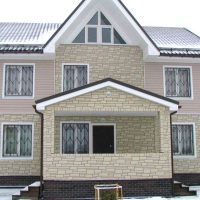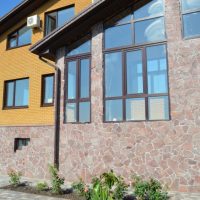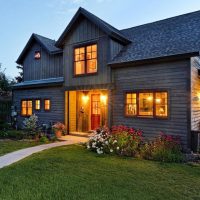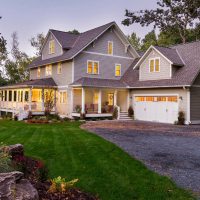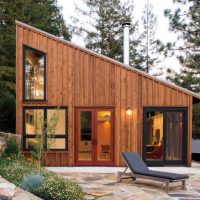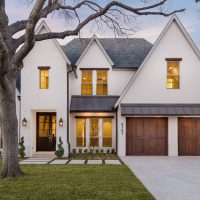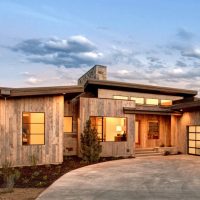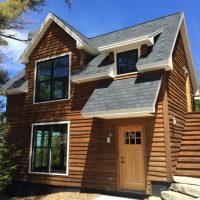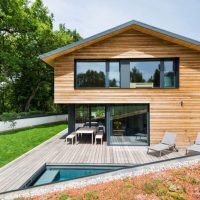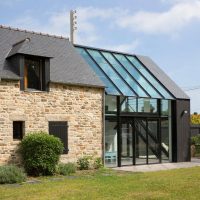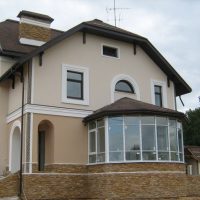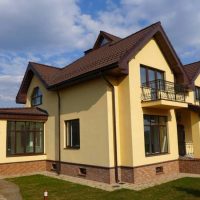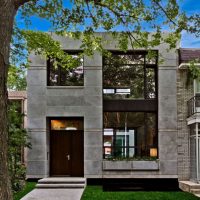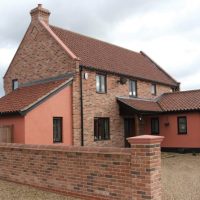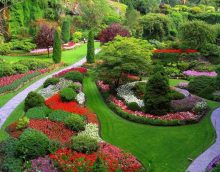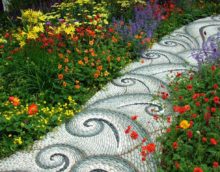Facade design as an integral part of home design
The aesthetics of the facade of the house is no less important than the aesthetics of the interiors. The design of the facade should combine internal and external space into a common idea and harmoniously include the building in the surrounding landscape. In addition, the decoration of the facades protects the basic structures of the house and contributes to their strength and durability. Therefore, the design of the facade is meticulously, to the smallest detail, developed at the earliest stage of building design - creating a sketch - and is a significant component of the entire architectural concept of the future building.

The appearance of a residential building plays an important aesthetic role.
Content
Design Features
When creating a facade design project, not only the interior decoration style of the house, formed on the basis of the tastes of the owners, is taken into account. The characteristics of the selected materials should correspond to the climate in the region; materials, in turn, dictate the direction of style. The architecture of neighboring buildings also has some influence: the new house should support the overall style of the housing estate, and not become a foreign spot in their background.

Properly selected finish is a spectacular view of the structure and its durability
In addition to the above, it is important to consider the basic aspects of the design of the facade:
- The color scheme in the design of facades is important not only as a stylistic nuance; color will affect the psycho-emotional state of both owners and visitors.
- Different materials in certain combinations will give expressiveness to the building, visually fragment the array of facades.
Style selection
The design of the facades today does not have a strict binding to the canons of one or another style. The trend is a certain eclecticism, the combination of elements of two or three related architectural directions. Such a structure looks fresh, unbanal and bears a touch of exclusivity.

The design style of the facade depends on the material chosen, and vice versa, if the style is already known, then finishing materials are selected for it
Nevertheless, the characteristic stylistic elements of the facade design must correspond to the intended purpose of the building. The most typical areas of architecture suitable for decorating the exterior of a country house:
- classic style;
- country style;
- Art Nouveau style;
- hi-tech style.
Classic facade design
The classical style in the design of the facades is expressed by the nobility of proportions, the symmetry of the silhouettes, the restraint of color combinations and the sophistication of decorative elements that emphasize the high status of the owner. Painted stucco, natural stone or its imitation, columns and arches, stucco molding and carving will logically complete the style of the building and give it fashion.

Baroque architecture is pomp, luxury and richness of decoration

Classical Russian architecture is very similar to Byzantine
Country Style Facade Design
Country or rustic style can be equally called ethnic: it includes the Russian tower with lace platbands and balusters, and the German fachwerk with an overhanging attic, and a pastoral Swiss chalet, and a slender English cottage. Of the materials, preference is given to natural wood, natural stone and ceramics, natural textures and a warm palette of colors, characteristic of the surrounding landscape. Rural motifs in the design of the facade will make the country house cozy.
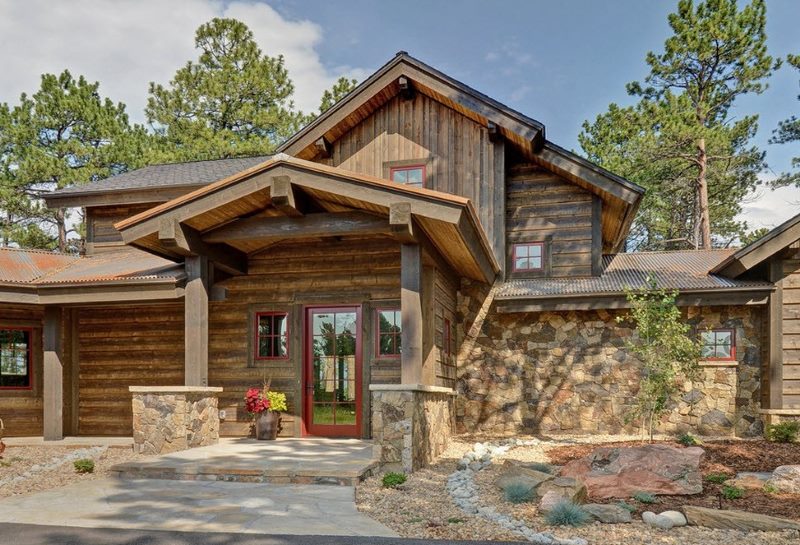
Country style log house
Art Nouveau facade design
The facade design of the house in the Art Nouveau style - brick lining, vertically elongated silhouettes of carpentry elements, openwork forging and "shop" windows; graceful lines and pearl shades.
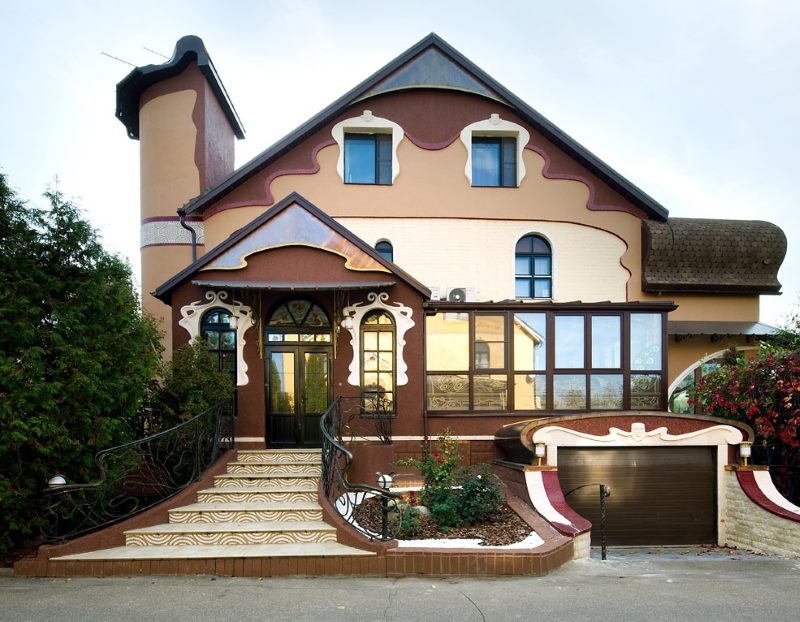
Art Nouveau facades, on the one hand, combine the traditions of long-existing styles, on the other - complement them with original features
Modern facade design
Stylish neo-loft meets all the requirements of modern design and effectively contrasts with the natural background. The conciseness of forms and the functionality of the space are also reflected in the exterior: simple stucco of dark muted tones, glass walls, metal "industrial" structural elements are the main features of modern private houses in high-tech style.

The modern design of the facade is a kind of mix, borrowing from various stylistic trends

Modern style is characterized by straight lines, clear geometry and a vast building area
Selection of finishing materials
Modern methods of decorating country houses involve the use of both traditional finishing materials and new composite ones - porcelain stoneware, clinker bricks, raised timber and acrylic stone. The combination of textures allows you to create a unique design of the facade of a country house in a wide variety of architectural styles.

The technology for facing the building depends on the material used for finishing
The following materials can be used for facade cladding in accordance with the architectural direction of the exterior of the house:
- decorative plaster;
- ceramic tile;
- natural or artificial stone;
- siding;
- decorative brick.
Each option has its own distinctive features, characteristic advantages and disadvantages.
Plaster
The construction market offers a lot of varieties of stucco for exterior surfaces.

Stucco - the most budgetary option for transforming the facade of the house
Mineral plaster is a traditional and least expensive, but also the least durable and plastic option, prone to cracking. The main advantage of mineral plaster in its porous structure: cinder block walls insulated with mineral slabs will breathe under a layer of mineral plaster.

One of the advantages of plaster is its wide color gamut, there are no restrictions
Acrylic plaster has high ductility and moisture resistance, but is practically vapor tight. Acrylic mixes are suitable for wall decoration with polystyrene foam as a heater.
Silicate plaster, along with elasticity and permeability, has antistatic properties, which is important for gassed areas. One of the most expensive types at the cost of the material itself and at the cost of its installation; Nevertheless, the costs are fully paid off with longevity.

Stucco fits well in almost any style
Silicone plaster absorbed all the advantages of the above materials and at the same time is more than attractive.
Siding
There are three types of siding:
- wooden;
- metal;
- vinyl.
The history of wood siding dates back several centuries, and the popularity of this material remains unchanged. Modern methods of wood processing - for example, impregnation - make planken even from short-lived varieties extremely resistant to all types of decomposition.

Modern wood siding is quite durable and can serve for decades, provided that the protective coating is timely updated.
Wood cladding is organic not only in rural façade design. Imitation of glued beam in the decoration of laconic hi-tech forms looks original and spectacular.
The aesthetic variety of metal siding allows you to create very spectacular and bright facades.The main disadvantage of metal siding - the tendency to corrosion - makes it a material for houses standing in open areas.

Imitation metal siding
Polyvinyl chloride siding has appeared relatively recently. As a protective coating of the facade, PVC siding has a number of significant advantages: it slightly increases the specific weight of the building, and therefore is suitable for decorating houses on shallow foundation; It creates reliable protection of walls from atmospheric influences, including UV radiation, and has sufficient vapor permeability. At the same time, it is environmentally friendly, easy to use and durable.
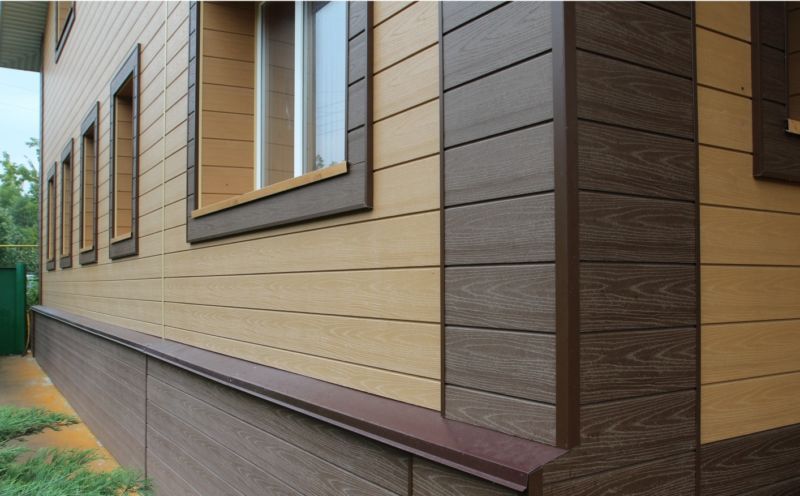
Using vinyl siding, you can beat the texture of any natural material
Modern, practical and relatively inexpensive finishing material will well support the country style in its Western European versions. Some types of vinyl siding imitate debarked logs, with such siding you can complete the stylization of a country house under a Russian estate.
Tile
Facing tiles are preferred on non-shrinking buildings of frame type, on buildings made of materials with minimal shrinkage (foam or aerated concrete) or on the walls of a long-built building.

The texture, shape and color of the facade tiles are very diverse
Ceramic tiles are equally relevant in the classic design of facades, and in the modern, in a monolithic version of wall decoration and as accent fragments combined with contrasting textures.

Installation work can be done independently, it is enough to have a little experience in this area
If imitation of a brick or chopped stone is used, it is worth paying attention to the color of the grouting composition in order to achieve the most expressive effect. If the base and perimeters of the openings are faced with large elements, and the planes of the walls are smaller, then the exterior becomes monumental and respectable.
A rock
Durable, reliable and almost timeless finishing material, the decorative capabilities of which are incredibly wide and universal. Limestone and sandstone are irreplaceable elements of decoration in the design of the facades of an English cottage; granite and marble - in the design of the basement and openings for a classic country house, dolomite - in giving the country house a unique Mediterranean flavor.

Facing the facade with stone takes a lot of time, and it requires high-quality surface preparation

But this design will give the house a chic representative look
Artificial stone has similar performance characteristics, but much richer in terms of colors and textures. In addition, polymer stone tolerates restoration well.
Brick
A solid, solid and respectable look to a country house in the Art Nouveau style will give the facade a brick finish, especially with a bright, contrasting grout.
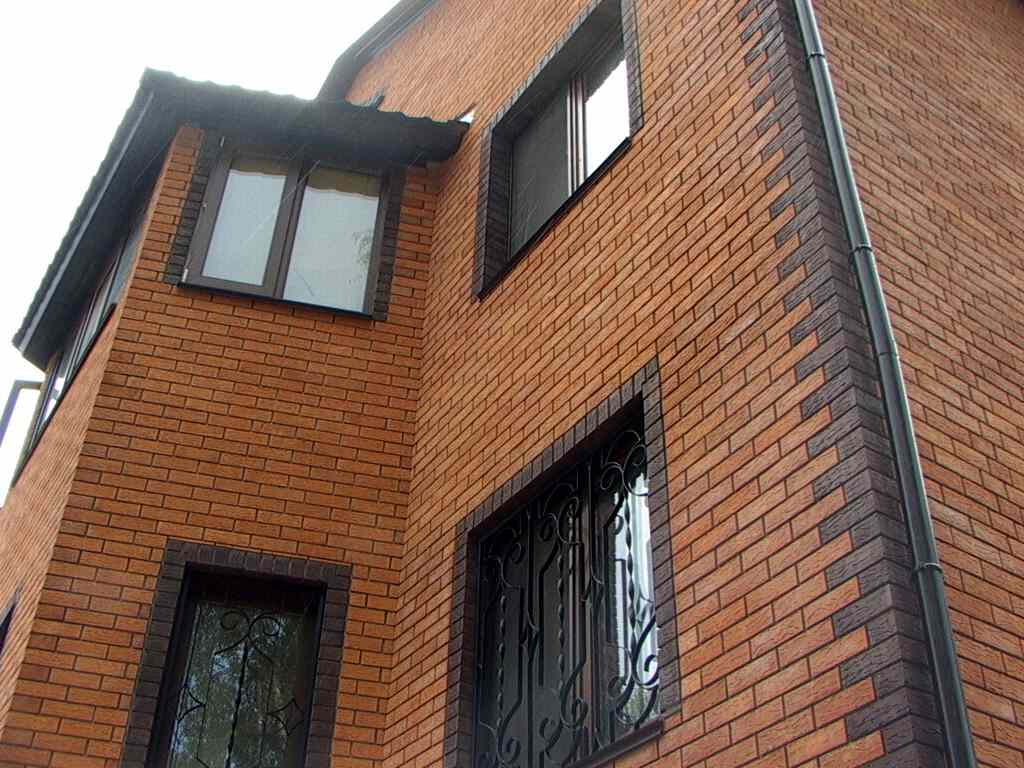
Brick - the oldest decoration material
Typically, brick cladding is carried out simultaneously with the construction of walls. However, subsequent facades are also possible to enhance and decorate obsolete unpresentable structures. It is important to arrange high-quality ventilation to prevent the destruction of the building material of the walls. Brick, like stone, increases the heat and sound insulation of the load-bearing walls of the house.

Bricks are often used in combination with other decorative materials.
In addition to the architectural style, the choice of materials for facade cladding is influenced by many aspects: their specific gravity, thermal insulation properties, environmental friendliness, topography and climatic features of the building site.
DIY facade design
It is unnecessary to remind that designing requires extensive knowledge in the field of normative acts and free orientation in the specifics of the building materials market; for a layman this can be of some difficulty.Alteration of the facade of a previously built house is complicated by the need to completely dismantle the old decor. Also, not all finishing work can be done qualitatively, relying only on ingenuity. In some cases, it will be cheaper to resort to the help of professional designers and experienced finishers.
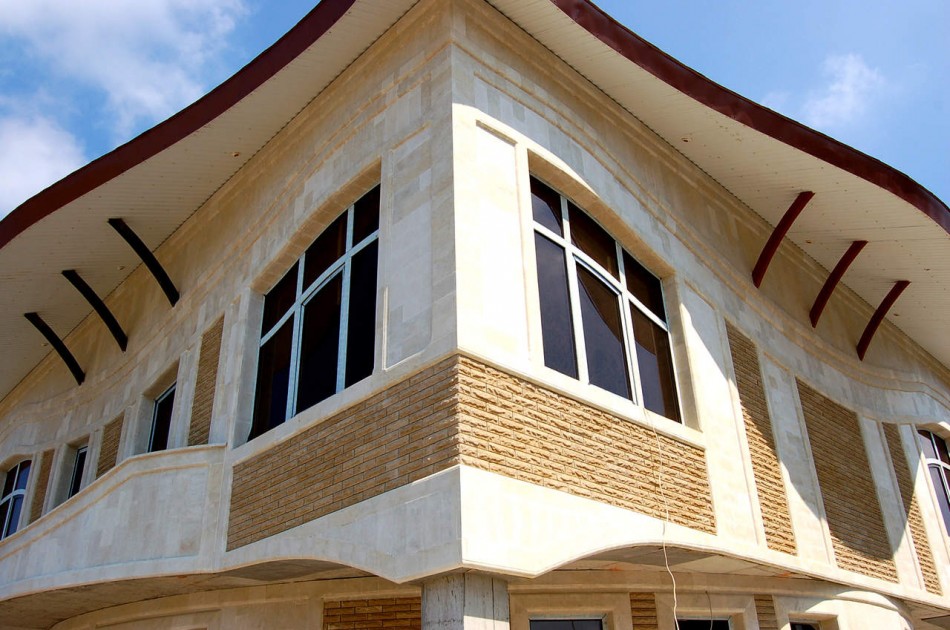
Facing the facade can unrecognizably change the appearance of the house
The entire process of facade decoration can be divided into four stages:
- The starting point of the design project of the facade of a country house is the moment of transferring the plan to paper, that is, creating a sketch of the future finish. Its development involves the careful thought out of every aspect - from color combinations to the location of all decor elements relative to the design of the house.
- The second phase is design. For an already built house, this requires accurate measurements of all external planes. Many computer programs allow visualization: a three-dimensional model makes it possible to evaluate and, if necessary, adjust the design project.
- Now you can start calculating the costs. Costing supplies and installation work will show an approximate amount of expenses.
- The final stage - decoration - can be done independently, it is enough to follow the principle of unity of individual decorative details of the stylistic integrity of the entire exterior.
Decoration Methods
The classic way to decorate the facade is landscaping. Pastoral flower boxes or flowerpots hung from window sills, or climbing roses, grapes and ivy, wrapped around columns or crawling along walls and shading windows, will become a romantic and cozy design element. The contrast of carved greenery and stone or brickwork, delicate and bright petals on a background of gray stucco will help create a unique mood for the whole house. This technique is appropriate in classic and rustic design styles.

Vertical facade greening with climbing plants
One of the modern methods is backlighting. Playing with light, you can highlight individual architectural details and create various visual effects. In the houses of the Art Nouveau or neo-loft style, spacious window-windows become the highlight elements, and by supporting them with additional lamps, you can enhance the sound of the style.
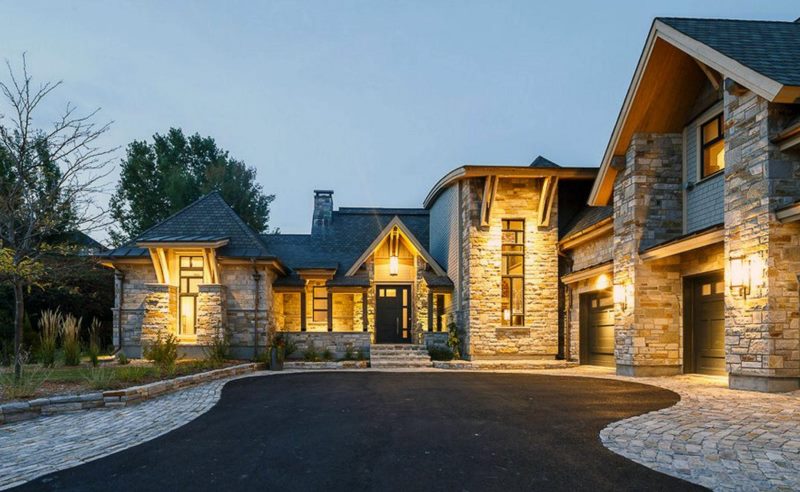
Illumination of the facade will decorate the house in the dark and at the same time illuminate the nearby territory
Video on how to choose a material for the facade




